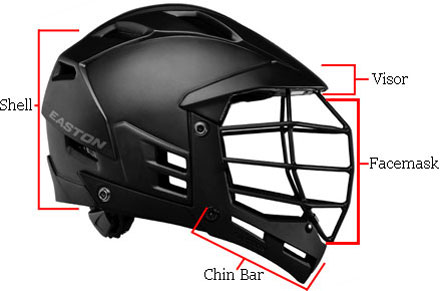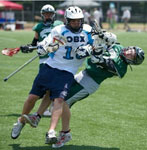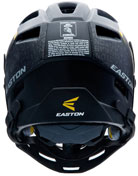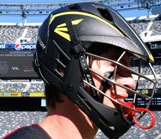How is a lacrosse helmet designed?
To protect your head, neck, and face from injury on the field, lacrosse helmets are designed for full cranial protection. That means a complete shell surrounds the head, and integrates with a full facemask for total protection. When worn properly, lacrosse helmets protect you from hard shots, high checks, and reduce the risk of head and spinal injuries.
Below are the parts of a lacrosse helmet, which may vary slightly from helmet to helmet.

- Hard plastic shell - Usually a single piece of impact-resistant, lightweight plastic or polycarbonate, the shell protects your head from impact without holding you back with added weight. Great helmets add ventilation holes and technologies into the shell for a more comfortable feel.
- Visor - When fitted properly, the visor keeps the sun out of a player's eyes, without obscuring vision. Typically integrated with the shell piece for a rigid protection system.
- Thick internal padding - The shell is lined with durable, impact-absorbing foam to disperse impact energy and protect the head from other injuries.
- Metal facemask - Typically made from strong, lightweight metals such as tungsten or steel, the grid-patterned facemask provides facial protection without obscuring visibility. High-performance helmets should provide wide facemasks for greater range of vision.
- Chin bar - Integrated into the shell, the chin bar is designed to protect the chin while allowing easy communication and ventilation. Injection molded, or filled with fiberglass for a rigid, durable construction, the chin bar manages impact energy from front hits.
- Chin straps - Designed to improve fit and keep the helmet and chin bar in place while in motion.
Why do I need a lacrosse helmet?

Men's lacrosse is a full-contact, high-impact sport. Lacrosse padding and helmets keep players safe from stick checks, impacts between players, and hard shots and passes. They keep the face, head, and neck safe from injuries and abrasions.
Without a helmet, a player could be hit with a shot and end up with serious injuries to the face or worse. When you wear a high-grade helmet, you can take a hit like that and walk off the field uninjured, or even continue playing.
Does my lacrosse league require me to wear a helmet?
Helmets are required in all men's lacrosse and most youth boy's
lacrosse leagues. Womens and girls lacrosse operate under different rules, reducing
physical contact between players, and making helmets optional.
Typically,
female lacrosse players only wear
lacrosse goggles to protect their face and
eyes from high shots and accidental impacts. Only goalies in women?s lacrosse
are required to wear helmets.
How do I fit my lacrosse helmet?

When fitting a lacrosse helmet, it?s important to keep things snug, but comfortable. A safe helmet is one that stays on the head, doesn't shift as you move, and provides good visibility.
Most modern lacrosse helmets come in one size, with a micro-adjuster knob in the back. This knob tightens or loosens the helmet around the head, giving you a perfectly snug fit.
To properly fit a lacrosse helmet:
- Put your forehead in first, making sure your ears are comfortably tucked in.
- Adjust the knob for a snug fit in the back.
- Adjust the chin straps so you are still able to open your mouth and talk without disturbing the fit of the helmet
- Keep the visor pretty low over the eyes.
- Adjust the tilt of the helmet properly, so you are looking through the top bars of the facemask.

When a helmet fits correctly, it should sit squarely on the head, with the front of the helmet approximately one finger's width above the eyebrows, so it will protect the forehead. The helmet's padding should fit firmly on the head without being so tight as to give you a headache. However, the skin of your forehead should move as you move the helmet back and forth. Tighten the chin strap so there's no slack, for a perfect fit, and you are good to go!
What is helmet Tilt and how does it affect the helmet's fit and safety?

The term "tilt" refers to the look of the helmet as it sits on the player's head. More accurately, it describes how low the helmet sits on your head. Tilt is mostly for style, and is desired by most players for its intimidating look on the field.
Tilt has other uses besides making a player look menacing though. Angling the helmet correctly also helps with proper visibility and chin protection. Without tilting most helmets, you will look through the middle bar, which is incorrect and provides poor visibility. Tilting the helmet lets you see through the top bar sections, and delivers proper chin protection.
Can I customize a helmet to fit my preferences or team colors?
At Sports Unlimited, we offer total customization on a majority of our lacrosse helmets. With popular styles such as the Cascade CS-R Youth Lacrosse Helmet, and Cascade CPV-R Men's Lacrosse Helmet, players, parents, and coaches can select helmet, visor, and chin guard colors as well as decal options to completely customize their helmet. With almost endless combinations, you can get the exact look you want, and the safety you need, to play like a star on the field!

